15 Wildflowers That Grow in Illinois (with Pictures)
-
Jessica Kim
- Last updated:
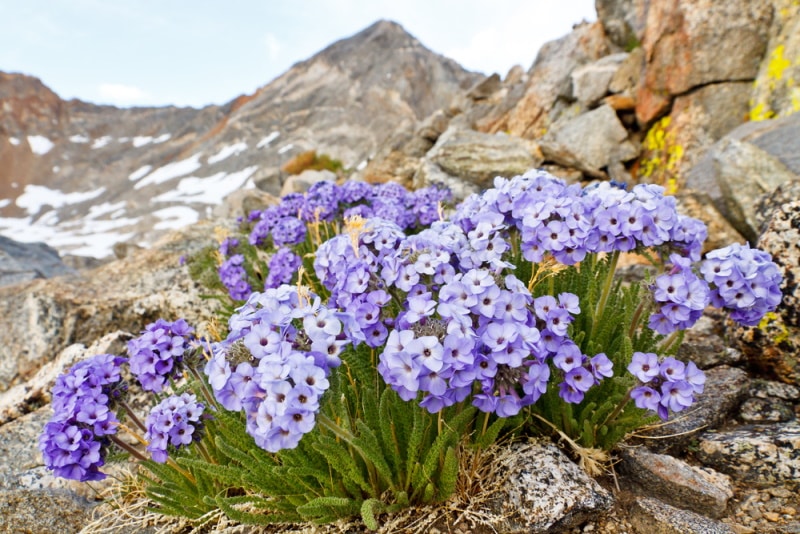
Wildflowers play a crucial role in ecosystems and directly benefit many insects, birds, and small animals. They’re natural food sources and attract pollinators, and some wildflowers can also be used for medicinal purposes.
Illinois is a biodiverse region with many different species of plants that can grow naturally without human interference. Here are some common wildflowers you can see in the beautiful Prairie State.
The 15 Wildflowers That Grow in Illinois
1. Aromatic Aster
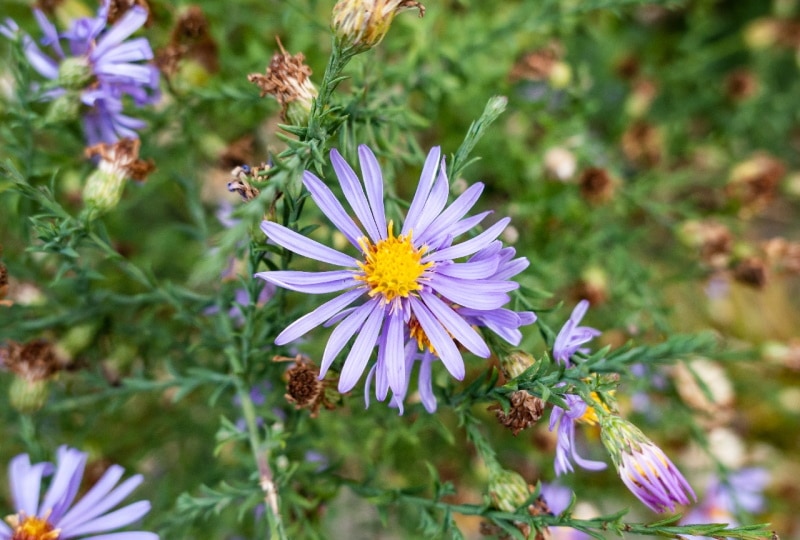
| Scientific name | Aster oblongifolius |
| Colors | Lavender |
Aromatic Asters produce daisy-like flowers with lavender petals. It grows well in sunny and dry conditions in open terrain with gravelly soil. It’s a favorite amongst many pollinators and attracts various species of bees and butterflies.
Aromatic Asters are a little rarer to see in natural habitats than other wildflowers, but you can usually find them growing in northern Illinois. They’re easy to grow and cultivate and are often popular for decorative gardens because of their long blooming season.
2. Bee Balm
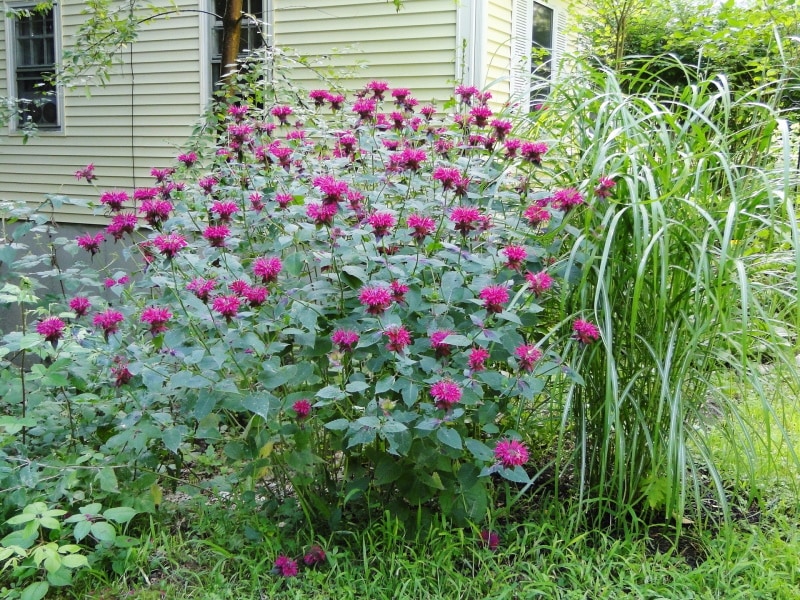
| Scientific name | Monarda didyma |
| Colors | Red |
Bee Balms produce beautiful, vibrant flowers that have a long bloom season. They also have a sweet fragrance and are particularly attractive to pollinators. So, they’re excellent additions to butterfly gardens.
This plant can be steeped in tea, and crushed leaves can be a natural mosquito repellant. Bee Balms are hardy, fast growers. So, they don’t require much care to grow, but you’ll have to keep an eye out for overgrowth and trim them back regularly to ensure they don’t overtake your entire garden.
3. Bloodroot
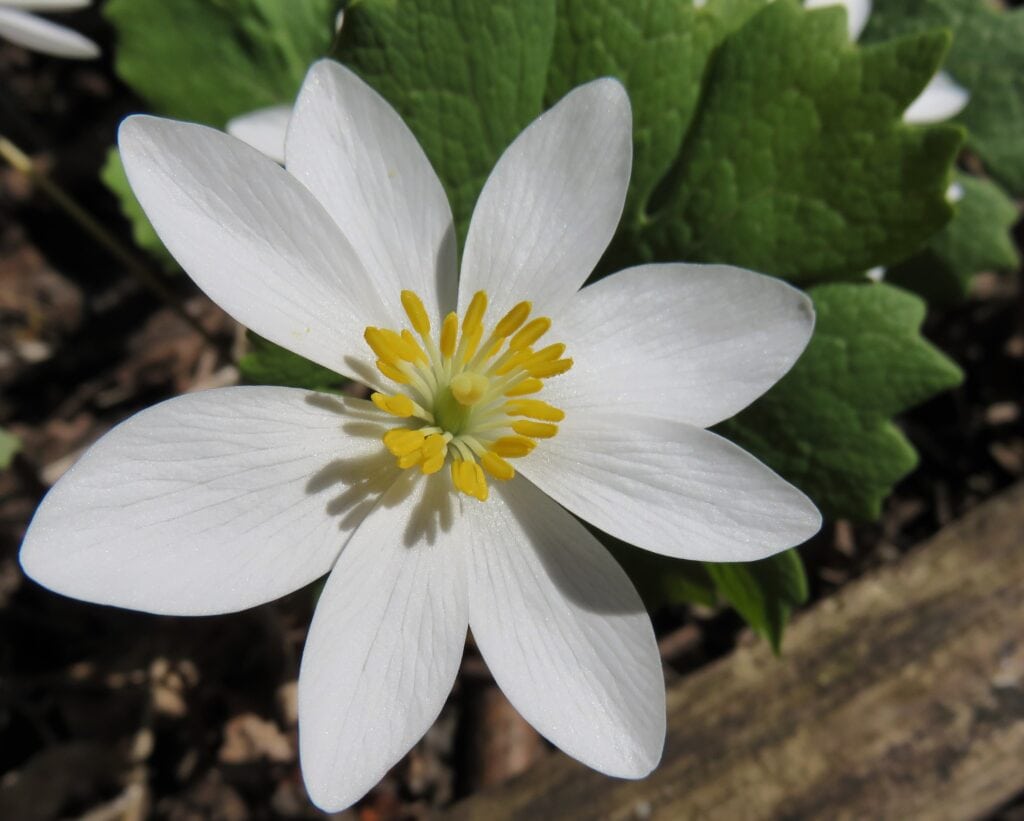
| Scientific name | Sanguinaria canadensis |
| Colors | White |
Bloodroots are early bloomers with flowers that start appearing in early spring and become dormant by midsummer. They grow in woodlands and floodplains and prefer moist, well-draining soil in shaded areas.
Bloodroot is known to have medicinal properties and is used for dental plaque and gingivitis. The stem contains reddish sap, which is used as a natural dye for shades of red, orange, and yellow.
4. Common Blue Violet
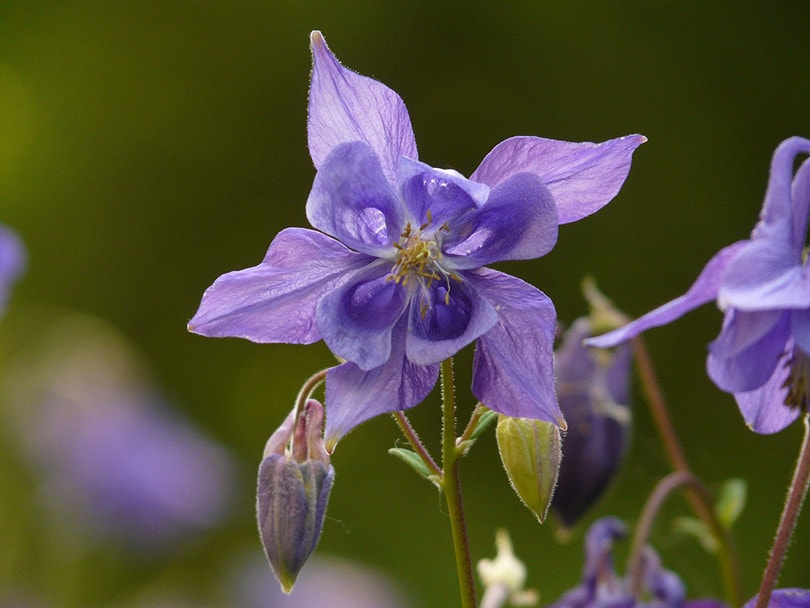
| Scientific name | Viola sororia |
| Colors | Violet |
Common Blue Violets can be seen throughout Illinois. This hardy plant grows naturally in forests, but they’re also known to thrive along busy roadsides and sidewalk cracks. Due to their hardiness and abundance, they’re often mistaken as weeds. However, these plants benefit the natural ecosystem and attract bees and butterflies.
The flowers and leaves are also edible and can be consumed cooked or raw. They’re often harvested from spring to summer when they’re producing leaves. It’s important to note that the roots are inedible and can cause an upset stomach.
5. Dutchman’s Breeches
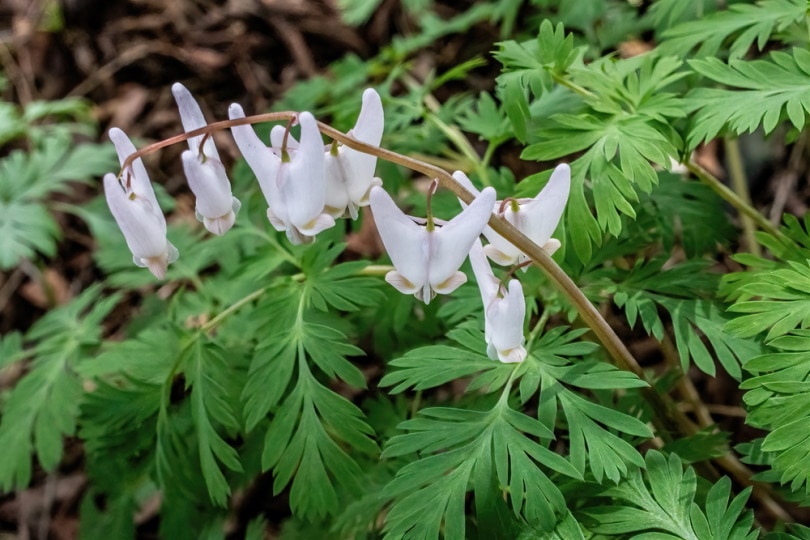
| Scientific name | Dicentra cucullaria |
| Colors | White |
Dutchman’s Breeches are easy to identify due to their unique flowers that are shaped like pantaloons. The flowers grow on leafless stalks, and the foliage consists of feathery, deep green leaves.
Dutchman’s Breeches are preferred by bumblebees and other insects with long tongues. They mostly grow in wooded areas and should be handled with care, as all parts of the plant are toxic and can cause mild skin irritation.
6. Goldenseal
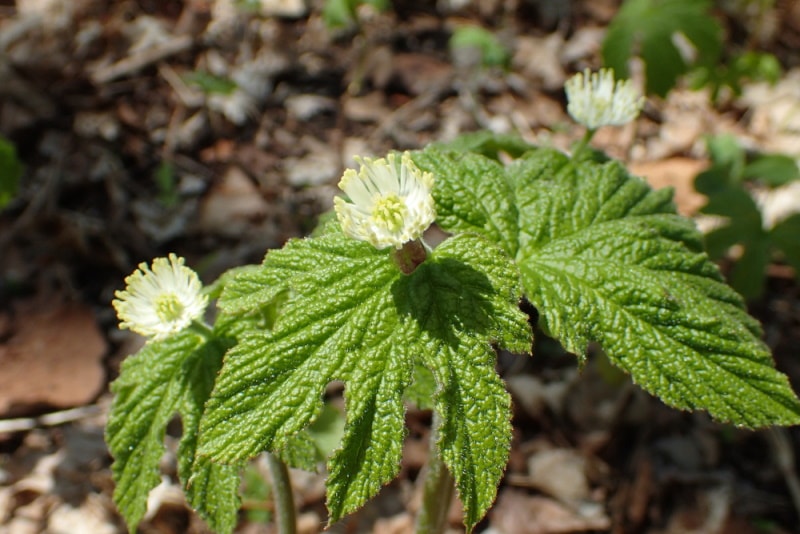
| Scientific name | Hydrastis canadensis |
| Colors | Green and white |
Goldenseal belongs to the buttercup family and is known for its medicinal properties. It’s often used to alleviate inflammation and indigestion. It grows abundantly in the eastern half of the US in woodlands.
Goldenseals produce fruit that looks like raspberries, but they’re inedible for humans. The flowers don’t have any petals. Instead, they grow numerous stamens and pistils, and they’re known to attract bees.
7. Jacob’s Ladder
| Scientific name | Polemonium reptans |
| Colors | Blue |
Jacob’s Ladder blooms beautiful bunches of small blue flowers with pops of yellow anthers. Its foliage is a stunning emerald and has small leaves that stick out from the stem and resemble ladder rungs.
Jacob’s Ladders are perennials that grow best in well-draining soil. It prefers partial shade and starts to bloom in early spring. This wildflower requires very little additional maintenance other than deadheading old blooms. It also does well in containers and lasts a while in vases.
8. Liverwort
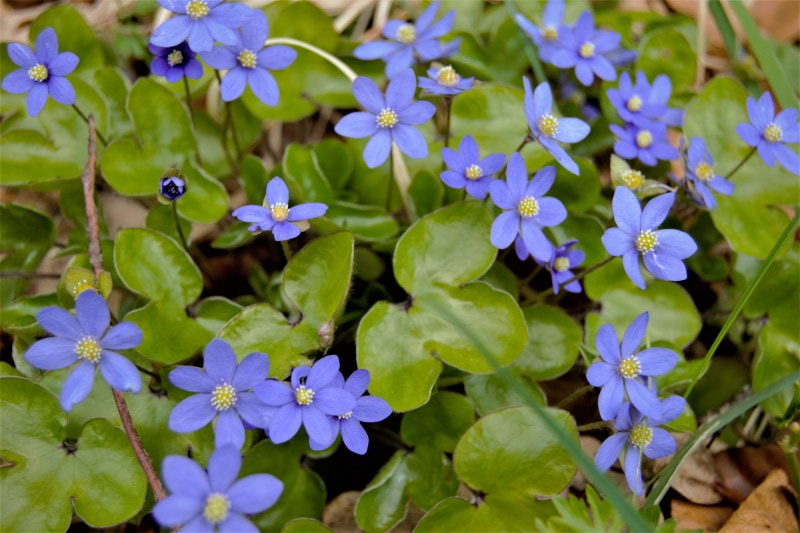
| Scientific name | Hepatica nobilis |
| Colors | Blue, pink, white |
Liverwort grows well in partial shade and well-draining, moist soil. The flowers come in several different shades and grow like anemones. They grow on hairy stems, and the leaves have a leathery appearance.
Liverwort grows in valleys and wooded areas along streams. While they’re hardy plants, they’re difficult to transplant and grow in new locations. Once they take root and bloom, they’ll attract pollinators, particularly butterflies.
9. Mayapple
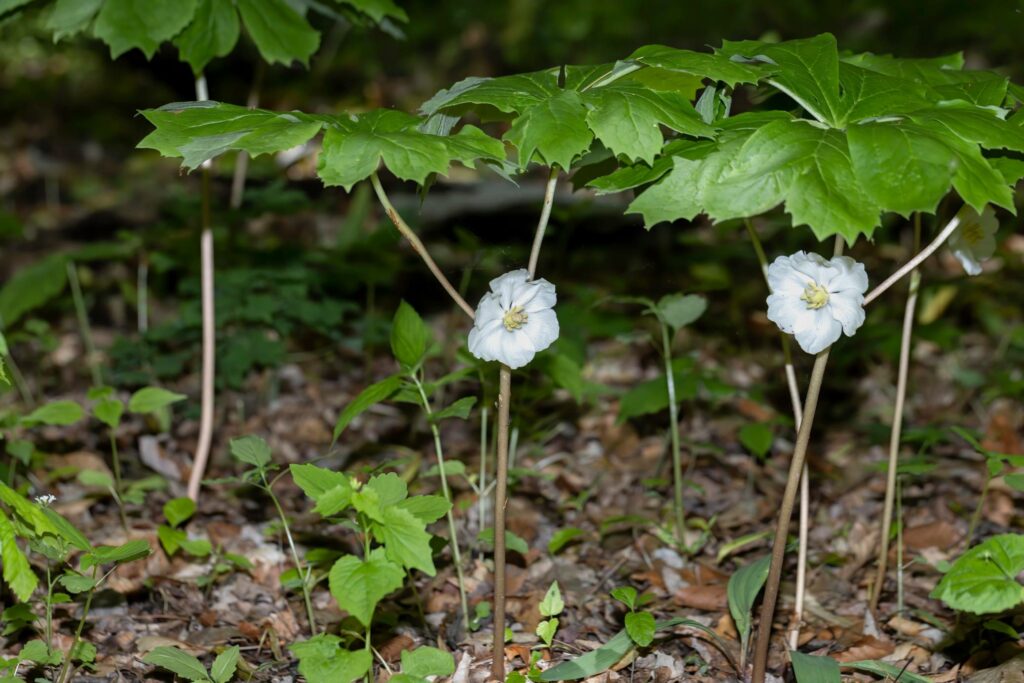
| Scientific name | Podophyllum peltatum |
| Colors | White |
Mayapples grow with just two leaves and one flower per plant. You’ll most likely identify these plants by the wide, umbrella-like leaves rather than the dainty white flowers. Mayapples can grow in considerably large colonies in wooded areas.
The plant’s leaves, roots, and seeds are toxic if they’re eaten in large quantities, but small amounts have been used to treat indigestion, jaundice, and fevers. Mayapples bear a yellow fruit that looks similar to a small, wrinkly lemon. The fruit is safe to eat when it’s completely ripe and has toxic properties when unripe.
10. Prairie Trillium
| Scientific name | Trillium recurvatum |
| Colors | Maroon |
Prairie Trilliums are rarer than most other wildflowers, but you can usually find them in wooded areas with a lot of shade. They also grow well in clay soil that’s kept moist. They grow beautiful, wine-colored flowers and have unique leaves with mottled patterns on them.
Once Prairie Trilliums are fertilized, they’ll produce berries that contain seeds. These berries are toxic and shouldn’t be eaten. However, the plant’s young leaves are edible and are often used for medicinal purposes.
11. Shooting Star
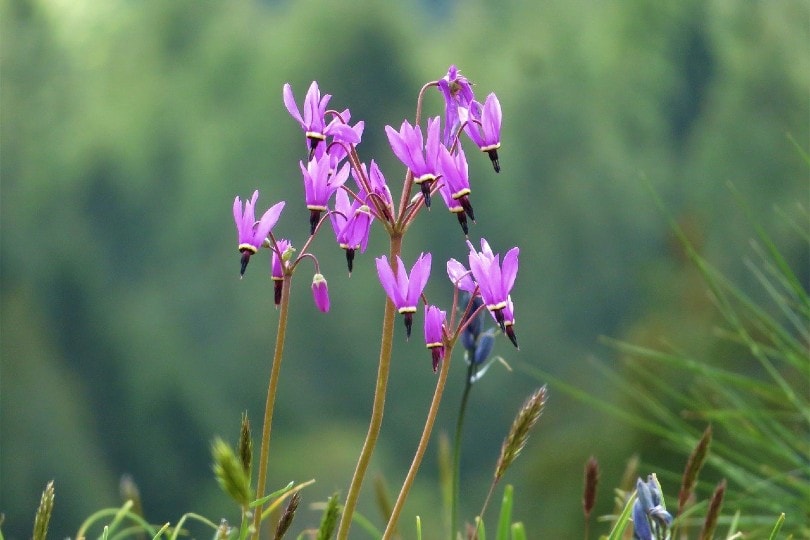
| Scientific name | Dodecatheon meadia |
| Colors | Pink, white |
This wildflower is commonly found in the central and eastern US in meadows, prairies, and woodlands. It prefers partial shade but can grow in full sun in cooler climates. It naturally thrives in well-draining soil, but it can grow in clay soil with a little extra care and attention.
Shooting Stars bloom in early spring, and the flowers usually fade by summer. Since the flowers don’t last very long, they should be planted near other plants that bloom later in the summer if you’d like them in an ornamental garden.
12. Solomon’s Seal
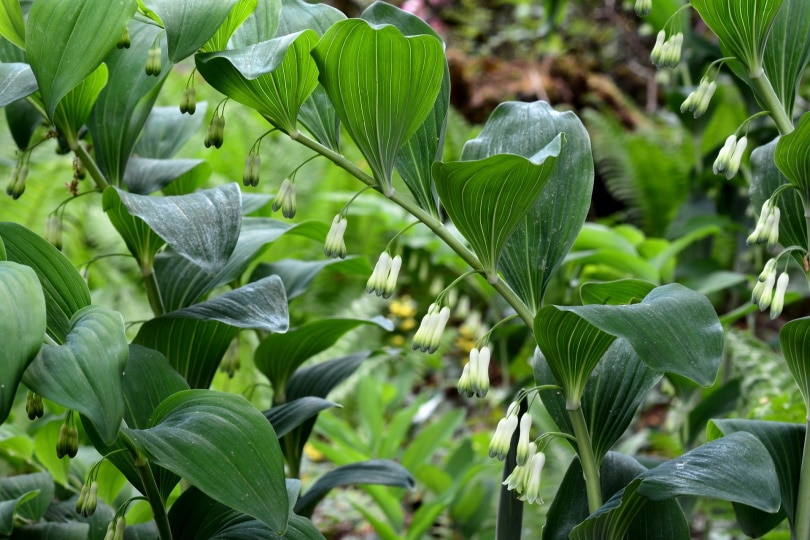
| Scientific name | Polygonatum commutatum |
| Colors | White |
Solomon’s Seal produces a line of delicate, white flowers along a single stem. Some varieties will have stems that grow upright, while others will arch. While the flowers are beautiful, they’re quite small and inconspicuous, so Solomon’s Seal’s foliage is more commonly used in spring bouquets.
This wildflower grows best in moist soil with partial to full shade. It prefers receiving morning sun, and the flowers may be too delicate for areas that receive strong afternoon light. It also has medicinal properties and is often incorporated into tea blends.
13. Spring Beauty

| Scientific name | Claytonia virginica |
| Colors | Pink and white |
Spring Beauties produce beautiful white petals with delicate pink stripes on them. They’re hardy wildflowers that grow throughout Illinois, and they’re often regarded as sure signs of spring. Since they grow so well on their own, their absence in wooded areas often indicates severe degradation in the past.
Spring Beauties grow best in loamy soil and partial shade. The flowers bloom fairly early and usually disappear by mid-summer.
14. White Trout Lily
| Scientific name | Erythronium albidum |
| Colors | White |
The White Trout Lily is a perennial flower that grows a single white flower on a flowering stalk. The flowers eventually bend downward, so they appear to grow upside down when you look at them from a distance.
White Trout Lilies grow in most regions in Illinois, except for the northwestern corner of the state. You can mostly find them in woodlands, and they can quickly grow in large colonies if left undisturbed.
15. Woodland Phlox
| Scientific name | Phlox divaricata |
| Colors | Light blue, violet, white |
Woodland Phloxes grow best in wooded areas with moist, well-draining soil and prefer partial shade. They can be quite resilient once they establish themselves and can even grow in clay soils.
This wildflower has a long stem and attracts pollinators with long tongues, such as butterflies and hummingbirds. So, these flowers are a great option if you’re looking to plant a butterfly or hummingbird garden.
Conclusion
Many beautiful wildflowers grow all through Illinois. It can be a fun hobby to identify the different kinds of flowers as they start to pop up in the spring. You can also plant wildflowers in your garden if you’re looking for low-maintenance plants that can support ecosystems and boost biodiversity. Since many wildflowers benefit the environment, it doesn’t hurt to get to know the different species that grow in Illinois so that you can protect them and help them continue to thrive.
Featured Image Credit: Patrick Poendl, Shutterstock
Contents
